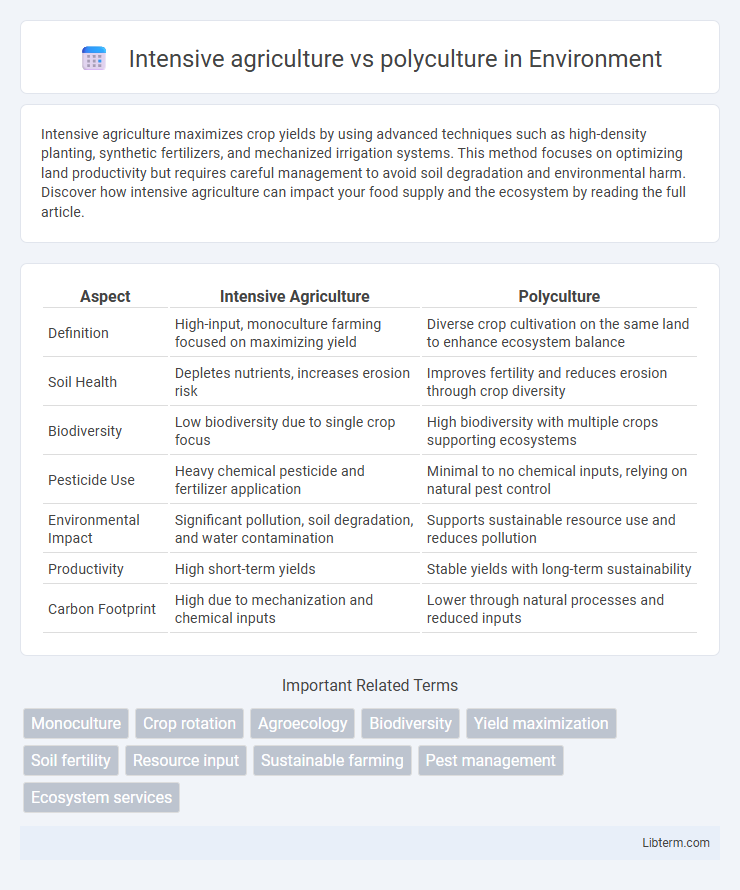Intensive agriculture maximizes crop yields by using advanced techniques such as high-density planting, synthetic fertilizers, and mechanized irrigation systems. This method focuses on optimizing land productivity but requires careful management to avoid soil degradation and environmental harm. Discover how intensive agriculture can impact your food supply and the ecosystem by reading the full article.
Table of Comparison
| Aspect | Intensive Agriculture | Polyculture |
|---|---|---|
| Definition | High-input, monoculture farming focused on maximizing yield | Diverse crop cultivation on the same land to enhance ecosystem balance |
| Soil Health | Depletes nutrients, increases erosion risk | Improves fertility and reduces erosion through crop diversity |
| Biodiversity | Low biodiversity due to single crop focus | High biodiversity with multiple crops supporting ecosystems |
| Pesticide Use | Heavy chemical pesticide and fertilizer application | Minimal to no chemical inputs, relying on natural pest control |
| Environmental Impact | Significant pollution, soil degradation, and water contamination | Supports sustainable resource use and reduces pollution |
| Productivity | High short-term yields | Stable yields with long-term sustainability |
| Carbon Footprint | High due to mechanization and chemical inputs | Lower through natural processes and reduced inputs |
Introduction to Intensive Agriculture and Polyculture
Intensive agriculture emphasizes high-yield crop production through the extensive use of chemical fertilizers, pesticides, and mechanization, focusing on monoculture systems to maximize output on limited land. Polyculture involves the simultaneous cultivation of multiple crop species in the same area, promoting biodiversity, soil health, and natural pest control. The contrast between these methods lies in resource utilization and environmental impact, with intensive agriculture prioritizing productivity and polyculture aiming for sustainability.
Historical Development of Farming Systems
Intensive agriculture emerged during the Industrial Revolution, characterized by high inputs of labor, fertilizers, and machinery to maximize crop yields on single-crop farms. In contrast, polyculture has ancient roots in traditional farming, involving the cultivation of multiple crops simultaneously to enhance biodiversity and soil health. The shift from polyculture to intensive agriculture marked a significant transformation in agricultural systems, driven by the need for increased food production during periods of rapid population growth.
Core Principles of Intensive Agriculture
Intensive agriculture emphasizes maximizing crop yield on limited land through high inputs of labor, fertilizers, pesticides, and irrigation. Core principles include monoculture practices, mechanization, and synthetic chemical use to boost productivity and efficiency. This approach contrasts with polyculture, which relies on biodiversity and intercropping to enhance soil health and reduce pest pressures naturally.
Core Principles of Polyculture
Polyculture emphasizes biodiversity by cultivating multiple crop species in the same space, promoting natural pest control and enhancing soil health through synergistic plant relationships. This practice reduces dependency on synthetic inputs and mitigates the risks associated with monoculture's uniformity. Intensive agriculture, in contrast, prioritizes high-yield monocrops with heavy use of chemical fertilizers and pesticides, often leading to soil degradation and decreased ecosystem resilience.
Productivity and Yield Comparisons
Intensive agriculture typically achieves higher productivity and yield per unit area by utilizing monoculture practices combined with synthetic fertilizers, pesticides, and mechanized equipment. Polyculture systems often produce lower overall yields per crop type but can result in more resilient, diversified output and improved soil health, leading to sustainable productivity over time. Yield comparisons show intensive agriculture maximizes short-term output, while polyculture enhances long-term ecosystem stability and reduces vulnerability to pests and diseases.
Environmental Impact Assessment
Intensive agriculture often leads to soil degradation, water pollution from chemical runoff, and decreased biodiversity due to monoculture practices. Polyculture enhances environmental sustainability by promoting soil health, reducing pest outbreaks naturally, and supporting diverse ecosystems through crop variety. Environmental Impact Assessments reveal polyculture as a viable alternative to intensive agriculture, significantly lowering carbon emissions and preserving natural resources.
Soil Health and Fertility
Intensive agriculture often depletes soil nutrients rapidly through monocropping and heavy chemical inputs, leading to reduced soil fertility and increased erosion risk. Polyculture enhances soil health by promoting biodiversity, improving nutrient cycling, and maintaining organic matter content, which supports sustainable fertility levels. Diverse plant root systems in polyculture ecosystems also boost soil structure and microbial activity, fostering long-term soil resilience.
Biodiversity and Ecosystem Services
Intensive agriculture often reduces biodiversity by relying on monocultures and heavy chemical inputs, which degrade soil health and disrupt ecosystem services such as pollination and nutrient cycling. Polyculture enhances biodiversity by cultivating multiple crop species simultaneously, fostering habitats for various organisms and improving ecosystem resilience. Maintaining diverse plant species in polyculture systems supports natural pest control, soil fertility, and water retention, contributing to sustainable agricultural productivity.
Economic Viability and Farm Sustainability
Intensive agriculture maximizes short-term economic viability through high-yield monocultures and extensive use of chemical inputs, but it often leads to soil degradation and increased long-term costs due to reduced farm sustainability. Polyculture enhances farm sustainability by promoting biodiversity, improving soil health, and reducing dependency on synthetic fertilizers and pesticides, which can stabilize economic returns over time. Economic resilience in polyculture systems is supported by diversified crop production, mitigating risks associated with market fluctuations and environmental stressors.
Future Prospects and Innovations in Agriculture
Intensive agriculture is advancing with innovations like precision farming, automated machinery, and genetically modified crops that enhance yield and resource efficiency for future food security. Polyculture systems are benefiting from agroecological research, integrating biodiversity to improve soil health, pest resistance, and climate resilience, which aligns with sustainable agriculture goals. Emerging technologies such as AI-driven monitoring and vertical farming promise to bridge intensive production with ecological sustainability, shaping the future of resilient and productive agricultural landscapes.
Intensive agriculture Infographic

 libterm.com
libterm.com